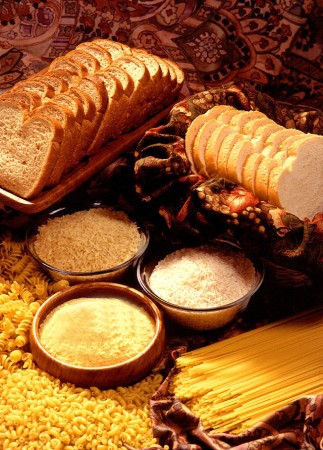
As part of the focus on the eatwell plate and healthy eating, this week we are looking at the 33% slice dedicated to starchy foods. Starch is an odourless, tasteless white substance which is found in plant tissue, grains and flours. It is an essential source of energy for humans and our main source of carbohydrate, another important energy source. Foods which contain starch are things like bread, pasta, cereals and potatoes.
Carbohydrates have got a bad reputation from the dieting world due to things like the Atkins diet which favours cutting out carbs altogether to aid weight loss, but the truth is that carbohydrates should make up large part of our meals every day as part of a healthy diet – cutting them out all together isn’t advisable. As you can see, this section takes up a third of the chart so it should play a significant part in your diet compared to the other sections.
So what are carbohydrates anyway?
Carbohydrates (carbs) are sugar molecules made of carbon, hydrogen and oxygen. The term refers to one or more of these molecules which are broken down into glucose to fuel cells from the brain to your muscles. There are three types:
Monosaccharide: contains one sugar molecule
Disaccharide: contains two sugar molecules
Polysaccharide: contains several sugar molecules. These are the ones which should feature in your diet in terms of starch intake. Examples include rice, corn, potatoes, bread and pasta.
As carbs are broken down they increase the amount of sugar in the bloodstream – your blood sugar level – and your muscles and liver store the sugar. When they are full, excess glucose is stored as fat.
You may have heard carbs referred to as simple or complex. The first two molecules are referred to as simple because they are easily absorbed into the blood stream due to their simple structure. Complex carbs (polysaccharides) take longer for the body to break down.
Carbs which are absorbed slowly are considered more healthy than the ones which cause your blood sugar to rise quickly. If they are whole (wholegrains), natural and unprocessed, they get the thumbs up. This doesn’t mean that you shouldn’t eat simple carbs – you should just take care not to over-eat them.

Simple carbs = found in cake, sweets, sugary cereals, refined breads
Complex carbohydrates = found in wholegrain bread, potatoes, beans
Starchy foods also contain fibre, calcium, iron and B vitamins.
Indigestible fibre
We are advised to eat foods like the skin on, like potatoes, wholegrains and cereals (all derived from plants) because they help our digestive systems get moving. They contain cellulose which is a polysaccharide and provides a protective coating or structure to fruits, vegetables and their seeds. It gives food a texture which is crunchy and helps us feel full so that we are less likely to over-eat. It’s found in the wholegrain versions of starchy carbohydrates and is also referred to as ‘roughage.’
As guidance, you can aim to base most meals on starchy foods such as toast for breakfast, a baked potato for lunch and pasta for dinner. Go for wholegrain options where possible and supplement your starchy foods with vegetables and pulses. So ignore what the food fanatics say – carbs are good for you! Try to avoid simple carbs like cake, sweets and fizzy juice and you should be on your way to a healthy, balanced diet.

